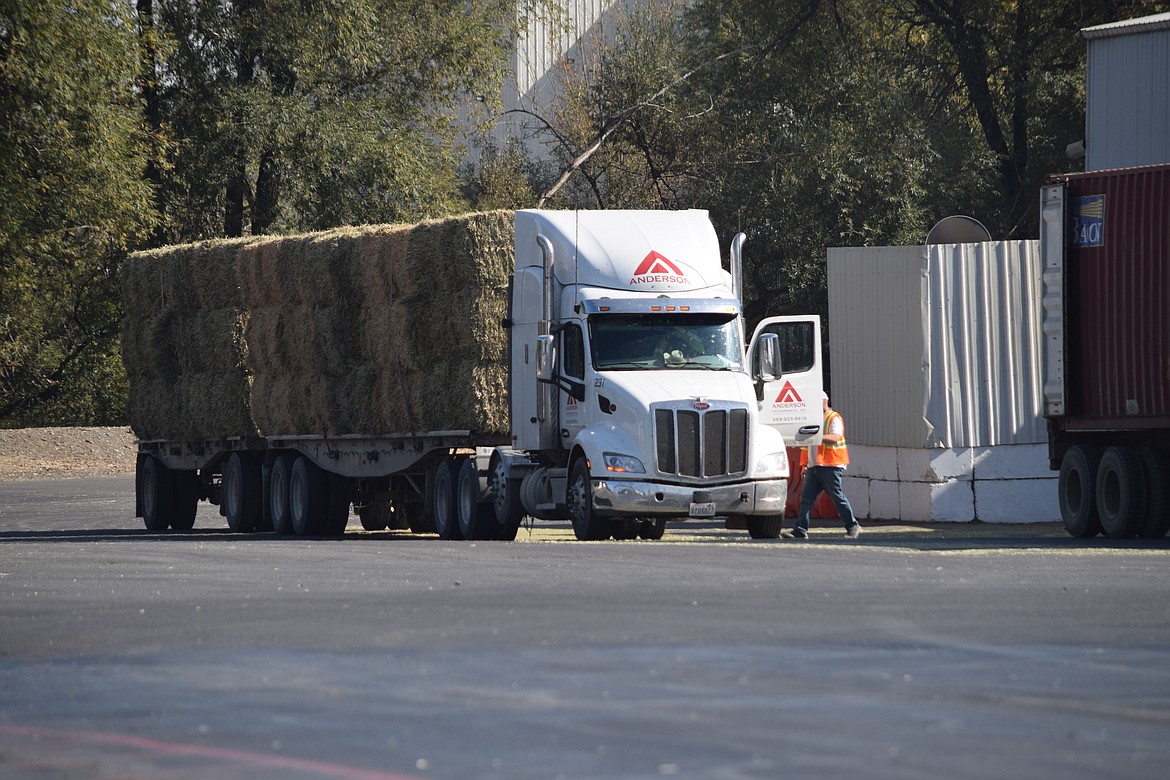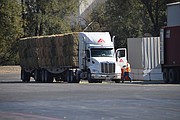Hay exports overcome transportation challenges
CHARLES H. FEATHERSTONE | Hagadone News Network | UPDATED 2 years, 2 months AGO
ELLENSBURG — For sheer value of Washington state’s farm exports, you can’t beat apples.
According to figures recently published by the U.S. Department of Agriculture, 2021 apple exports totaled nearly $2.2 billion, up 4.3% from apple exports in 2020, and roughly one-fifth of the total value of state farm product exports of $10.2 billion.
While a few farm commodities posted increases in 2021 from the previous year’s levels — the value of cattle and calf exports rose 13.6%, hop exports rose 8.4% — the USDA reported the value of most of the state’s farm exports fell in 2021, some by a little — the value of potato exports fell 5.4% — while wheat exports fell by a whopping 20.2%.
That likely reflects 2021’s drought-ravaged wheat harvest, which fell 48% to 87.2 million bushels from 166.2 million in 2020, according to a USDA report published in January 2020.
But it was the value of hay exports that posted the steepest year-over-year increase in 2021, according to the USDA, rising 20% to $602 million from $500 million the year before. This huge increase in the value of exports came despite the fact that the volume of hay exports rose only slightly in 2021 to roughly 4.25 million metric tons from 4 million metric tons in 2020, according to USDA figures.
“The majority of what we do is export,” said Mark Anderson, CEO of Anderson Hay and Grain in Ellensburg. “Our big purpose, our big why, is trying to take the headaches out of the hay business.”
Anderson Hay and Grain was founded in 1960 and has been exporting since 1971, Anderson said. In those five decades, Anderson said his company has developed relationships with hay growers across the Pacific Northwest and hay buyers across Asia. It’s a tough business, Anderson said, because the quality of alfalfa and timothy hay — the company’s primary exports — can vary widely between different farms and growing regions in the Pacific Northwest, while buyers want the best and most consistent quality they can afford.
“There are a lot of headaches that come with hay. It’s not made in a factory. So there are a lot of quality variances and grading and just a lot of elements that go into getting a ton of hay to a customer,” he said. “That’s a ton of hay they want when they want it in a guaranteed way. And if it’s not meeting all those expectations, we take care of it. So it’s a huge undertaking.”
Anderson said around 90% of the hay grown in the Western United States is consumed domestically — only 10% of that hay is exported. The 2021 drought also hit the region’s hay farmers hard, meaning many growers and many users started 2022 with low hay stocks as demand remained high.
“So, in many cases, there wasn’t enough hay to go around,” he said. “And we just saw a tremendous amount of energy start in the southwest, in Arizona and Southern California, with record high alfalfa prices and as harvest continued to move north, we just saw prices continue to hold and a lot of that was surrounding the question, is there enough hay to go around.”
Prices for high-quality alfalfa hay topped $400 per ton, Anderson said, and stayed high as dairy owners, cattle ranchers and horse owners all competed for the best hay they could find. According to USDA’s weekly Washington-Oregon (Columbia Basin) Direct Hay Report published the department’s Agricultural Marketing Service, mid-October prices in the Columbia Basin for new crop alfalfa hay ranged from a high of $360 per ton for premium grad alfalfa bound for dairy and feedlot use to $250 per ton for utility alfalfa listed as having excessive moisture.
By comparison, prices for supreme quality alfalfa hay in California went for as much as $478 per ton, according to the AMS weekly California hay price report.
Anderson said given strong domestic and international demand, the question — is there enough hay to go around? — has still not been answered yet.
“The domestic demand continues to be pretty high for quality hay going to horses, as well as the dairy industry, beef industry, we’re seeing high feeder prices,” he said. “I don’t think that question will be answered until (next) April or May.”
It doesn’t help that even as international demand remains high — especially among dairy operators in Japan, South Korea and the Middle East — the global shipping regime is still sorting out the dislocations caused by the COVID-19 pandemic.
“I’ve been involved in the exporting of hay since I started selling in the office in 1985,” Anderson said. “Never have I experienced the logistical nightmare that we experienced not just for a few months or six months, like a port strike or a labor strike, but a complete meltdown of the supply chain post-COVID.”
When the lockdowns restricted large numbers of people to their homes following the outbreak of COVID-19 in the United States in February 2020, demand for imported consumer goods rose significantly. Because of that, many global shipping companies found it was more profitable to quickly send empty containers back across the Pacific Ocean to China rather than fill them with U.S. exports like hay, leaving U.S. products to stack up across ports and terminals.
“It was incredibly difficult to keep product moving and keep customers happy and get exports of product on vessels because they were taking empties back,” Anderson said.
It’s gotten better in 2022, Anderson said, though shipping schedules are still a little out of whack. According to the website Statistica.com, which tracks global freight rates, the index tracking the cost of shipping a 40-foot container from China to the U.S. West Coast fell to 1,697 in September 2022 from a high of 2,714 in May 2022 but still considerably higher than 723 in January 2020, prior to the pandemic. The index began tracking container freight rates in January 1998, when it was set at 1,000.
“The market is slow enough that we’re getting everything shipped. We’re getting out of the terminals fairly well. We seem to find cargo space for everything,” Anderson said.
Anderson said demand for U.S. timothy and alfalfa hay remains strong because soils across the Western U.S. are good and between irrigation and rainfall, water is ample as well. In particular, Anderson praised the quality of the timothy hay grown in the Kittitas Valley, the Columbia Basin, and parts of Nevada as some of the best hay grown in the world. Even as hay production increases in countries like Canada, Australia and Spain, Anderson said high quality U.S. alfalfa and timothy hay will continue to find a niche with dairy producers and people who raise horses worldwide.
At the company’s sprawling facility on the west side of Ellenburg, Anderson said they take hay in, compress it, and pack it in containers bound for the Port of Seattle. Compressing the hay allows the company to double the amount they can ship in a typical container. Kept dry, the hay can retain its quality for up to two years, he said.
“We don’t add anything to the hay. We don’t take anything from the hay. We’re simply doubling the density and putting it in some form of package that makes it easier for the customer at the other end to handle,” he said.
And that customer could be a dairy farmer in Japan, a cattle rancher in South Korea, or a camel herder who breeds horses in the United Arab Emirates, Anderson said.
On the horizon, Anderson said he believes the future of the industry can be best secured by improving water management and ensuring that laws and regulations don’t keep U.S. farmers from being globally competitive.
“I think water in the West is probably one of the most mismanaged resources we have,” he said. “A lot of the ways we go about managing it were developed in the 1900s, and they haven’t changed since.”
The Yakima Basin and the Kittitas Valley still get enough rain, he said, but the days of having 15-foot snow packs in the mountains every year are gone, and that reality needs to be faced and properly dealt with, he said.
“We have to have a good supply of water for agriculture or agriculture doesn’t exist in Eastern Washington,” Anderson said.
Charles H. Featherstone can be reached at cfeatherstone@columbiabasinherald.com.
MORE FRONT-PAGE-SLIDER STORIES
ARTICLES BY CHARLES H. FEATHERSTONE

Potato prices up, sales down for first quarter 2023
DENVER — The value of grocery store potato sales rose 16% during the first three months of 2023 as the total volume of sales fell by 4.4%, according to a press release from PotatoesUSA, the national marketing board representing U.S. potato growers. The dollar value of all categories of U.S. potato products for the first quarter of 2023 was $4.2 billion, up from $3.6 billion for the first three months of 2022. However, the total volume of potato sales fell to 1.77 billion pounds in the first quarter of 2023 compared with 1.85 billion pounds during the same period of 2022, the press release noted. However, total grocery store potato sales for the first quarter of 2023 are still above the 1.74 billion pounds sold during the first three months of 2019 – a year before the outbreak of the COVID-19 pandemic, the press release said.

WSU Lind Dryland Research Station welcomes new director
LIND — Washington State University soil scientist and wheat breeder Mike Pumphrey was a bit dejected as he stood in front of some thin test squares of stunted, somewhat scraggly spring wheat at the university’s Lind Dryland Research Station. “As you can see, the spring wheat is having a pretty tough go of it this year,” he said. “It’s a little discouraging to stand in front of plots that are going to yield maybe about seven bushels per acre. Or something like that.” Barely two inches of rain have fallen at the station since the beginning of March, according to station records. Pumphrey, speaking to a crowd of wheat farmers, researchers, seed company representatives and students during the Lind Dryland Research Station’s annual field day on Thursday, June 15, said years like 2023 are a reminder that dryland farming is a gamble.

Wilson Creek hosts bluegrass gathering
WILSON CREEK — Bluegrass in the Park is set to start today at Wilson Creek City Park. The inaugural event is set to bring music and visitors to one of Grant County’s smallest towns. “I've been listening to bluegrass my whole life,” said the event’s organizer Shirley Billings, whose family band plays on their porch every year for the crowd at the Little Big Show. “My whole family plays bluegrass. And I just wanted to kind of get something for the community going. So I just invited all the people that I know and they’ll come and camp and jam.” ...





